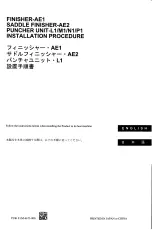
More About Flow Control for Serial Users
Desktop publishing programs often use DTR/DSR, while a
spreadsheet program in the HP emulation may use XON/XOFF. If
you are using a serial interface (RS-232C) between your host and
the printer, you may experience printing problems because your
software application program and your printer are using different
flow controls. The problem is usually noticed when sending long
documents to the printer. The first few pages are fine, then the
printer begins to print erratically or not at all. If this happens, you
must change the printer’s flow control setting. This may be done
two ways: either with the PS Executive Series Utilities, or
manually, by sending the necessary PostScript commands to the
printer.
The printer’s test configuration page (see chapter 2, “Printer Use”)
indicates the flow control protocol used by the printer at power up.
All the default settings communicate DTR/DSR. If there is no
statement of software protocol listed on the test configuration page,
you are still using the default DTR/DSR flow control protocol. If
flow control has been changed from the default, XON/XOFF
shows.
It can be more difficult to find out what flow control protocol your
software application program uses. Some application programs are
helpful and contain menu items allowing you to select your flow
control protocol. If so, make sure you select the same one used by
the printer. Check the printer test configuration page and choose
accordingly.
NOTE: Most PC applications use DTR/DSR protocol.
However, many application programs do not allow you access to
flow control protocol through their program. If you cannot
determine the protocol through the program itself, check the
Chapter 8
P r i n t e r / H o s t C o m m u n i c a t i o n
8 - 5
Summary of Contents for PS 410
Page 1: ...QMS PS 410 User s Guide 1800148 001E...
Page 8: ...v i...
Page 14: ......
Page 16: ......
Page 24: ......
Page 26: ......
Page 46: ......
Page 62: ......
Page 82: ......
Page 84: ......
Page 102: ......
Page 114: ......
Page 116: ......
Page 138: ......
Page 140: ......
Page 154: ......
Page 156: ......
Page 170: ......
Page 204: ......
Page 206: ......
Page 222: ......
Page 224: ......
Page 232: ......
Page 240: ......
Page 241: ...Appendix C Optional Accessories Available QMS Accessories C 1...
Page 242: ......
Page 245: ...Appendix D Character Encoding Tables Character Encoding Tables D 1...
Page 246: ......
Page 249: ...Appendix D Symbol Encoding Character Encoding Tables D 3...
Page 252: ......
Page 256: ......
Page 258: ......
Page 280: ......
















































